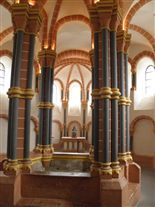P4140157.jpg
The Chapel - Click 'Details' for more information
In the basement of the lower chapel, excavations revealed remains of a square tower of a width of 10.50 meters. This tower has been identified as a roman 'castellum', having existed from the end of the 3rd to the first or the second half of the 5t' century, during the late Roman period. It appeared to have been destroyed by fire. During the Carolingian period, a first early medieval surrounding wall was built on the ruins of this Roman fortification.
The Chapel, the most remarkable part of the castle, is a double oratory, consisting of two separate floor-levels, which communicate by an opening in the middle. The lower floor was meant for the commoners of the town and the servants. They could follow the religious
Ceremonies through the six-sided opening, without being able to lncnetrate into the castle or to endanger or bother the count and his family seated on the upper level.
The Castle-Chapel, dedicated to St. Anthony, was the first church of Vianden. Hitherto the Basilica of Roth in Germany (erected towards 1136 by the archbishop of Trier, who had transferred it to Frederic I, count of Vianden) was the church of the inhabitants of Vianden.
In 1228 the counts of Vianden surrendered the Basilica of Roth to the Templars, who were also to read mass in the chapel of Vianden.
In 1248 Henry I called the Trinitarians to Vianden, who then celebrated mass in the castle-chapel. The angry Templars claimed that their rights had been hurt, and they even succeeded in having Henri I, Philip I and their wives excommunicated in Rome. The archbishop of'Trier tried to appease the two parties with a compromise by which he divided Vianden into two parishes. The Templars remained in charge of the left bank of the Our river, while the castle chapel became the parish church of the Upper Town.
